Temporal knowledge supervision for pre-training transfer learning models

Masked Language Model is effective to learn contextualized word representations from the huge amount of raw text. However, it can hardly emphasize temporal information, because [MASK] is randomly selected. We propose to apply an automated temporal IE (TIE) system to extract temporal knowledge from the raw text as the pre-training supervision. The proposal automatically extracts either explicit or implicit temporal knowledge to provide rich temporal supervision, compared to the existing work. We expect that our pre-training method can obtain temporal-aware representations with distributed duration, frequency, ordering information encoded.
Tract-based structural connectivity analyses of precuneus
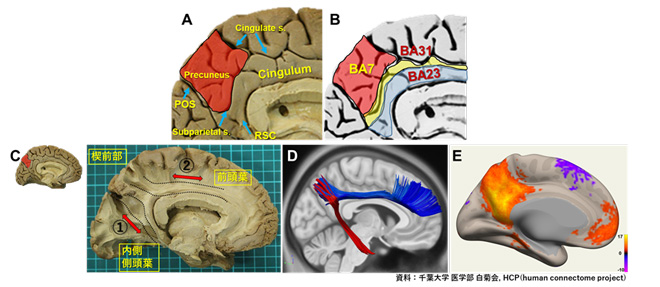
The precuneus is considered as a center of map generating mental time over the medial surface of the cerebral cortex. It is positioned on the medial surface of the parietal cortex as a rectangle-shaped area (A). The precuneus’ territory corresponds to the medial surface of Brodmann’s area BA7 (B). The aim of this study is to investigate the tract-based network of the precuneus by white matter dissection (C) and tractography (D). In addition, we would like to analyze the relationship between the structural connectivity and the resting-state functional connectivity (E) of the precuneus.
Machine's Time and Biological Time
Considering the difference between machine time and life time, we have experimented and discussed the fact that a single time axis in a living system is born from a set of countless time axes of episodic memory, and implemented it in a system called MTM (Mind Time Machine). The episodic memories stored in the MTM are scattered in a "latent space" without any relation to each other. A living system creates the subjective time by joining these episodic memories together in a consistent way. The aim of this research is to prove this hypothesis by creating an MTM.
Human visual perception is also inextricably linked to the perception of time. Structurally, it seems that human perception is not frame based, such as frames per second. We will test this and clarify the differences between machine vision and the human visual system.
Options of future action embedded in the dynamics of neural activity
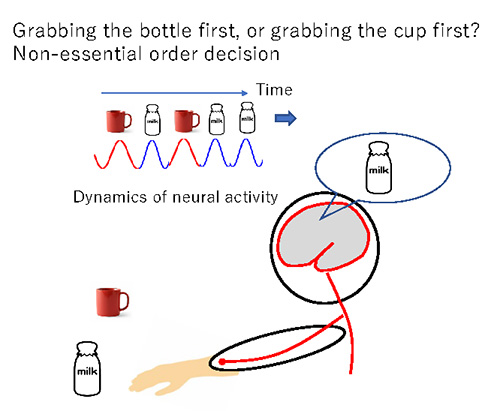
When multiple options are available, we compute and compare the value of each option to reach the decision. However, in many cases of our daily life, we face options that do not have apparent value differences. The goal of this project is to reveal another type of decision-making strategy which relies not only on value, but relies on the ongoing brain activity representing the options of future action.
Analysis of neuronal activity encoding the timing of movement with calcium imaging and optogenetics

In this project, we will investigate neural mechanisms on how sensory input generates neuronal activity encoding the timing of movement. To this, we record neuronal activity with one- and two-photon imaging techniques in several cortical areas of common marmoset performing a behavioral task. In addition, we modulate neuronal activity in the areas with optogenetic technique during the task to reveal how the activity in the area changes the activity in other areas and the behavior.
Understanding of neuronal networks that regulate sleep/wakefulness and time perception
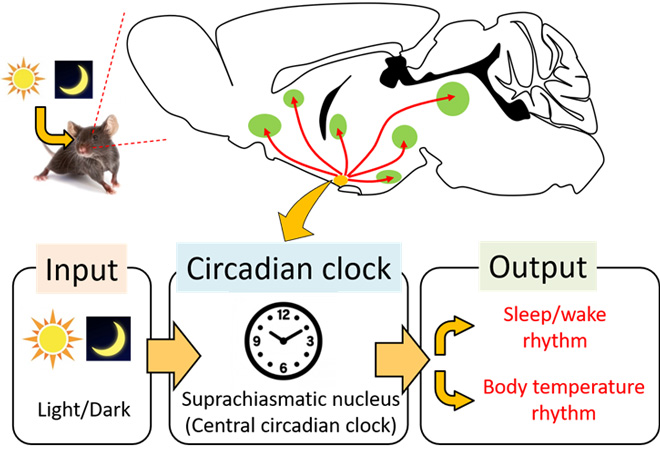
Jürgen Aschoff who created the foundation of modern chronobiology, discovered the existence of a circadian clock in human. He found that the circadian rhythms of body temperature and sleep/wakefulness in human showed different periods under constant condition, which called "internal dyssynchronization”. Importantly, time estimation is affected by circadian period of sleep/wakefulness not body temperature. In other words, we have two distinct oscillatory mechanisms which regulate sleep/wakefulness or body temperature. However, it remains unclear which neuronal pathways regulate these rhythms. In this study, we would like to identify the neural pathways which relate to sleep/wake rhythm and body temperature rhythm regulation starting from the central circadian clock, suprachiasmatic nucleus (SCN), and approach the significance of existence of two different times in human.
Forward and reverse engineering of a predictive motor control
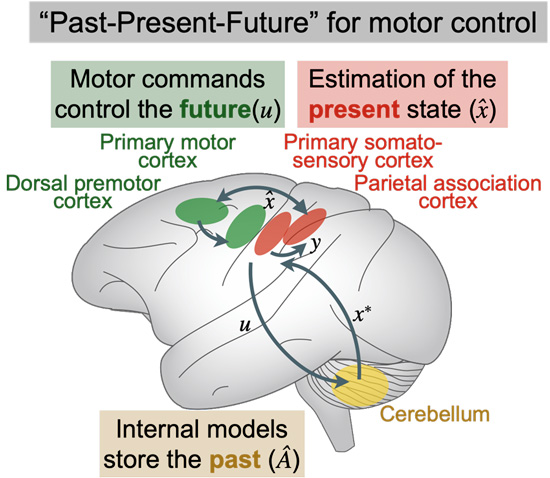
A hallmark of our motor system is the ability to predict the future changes in environment and our body and flexibly adapt current motor actions to them. The goal of this project is to understand the neural basis for predictive motor behaviour. Our approach is multidisciplinary, including i) constructing an artificial neural network model for the predictive motor control (forward engineering) and ii) manipulating real and artificial neural networks (reverse engineering). By taking advantage of these diverse techniques, we aim to identify the neural mechanisms for predictive motor behaviour.
Functional analysis of cell assemblies representing the end of event
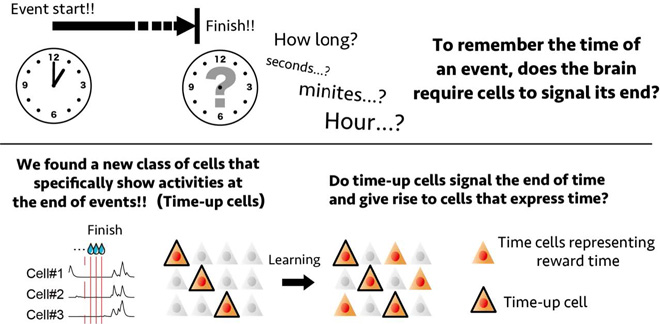
The hippocampus plays an important role in episodic memory formation including time and place corresponding to "when" and "where", respectively. A subpopulation of neurons that show sequential activity according to temporal events have been identified in hippocampal CA1. These are called time cells, which represent time for temporal events of a fixed length in seconds or minutes. However, it is unclear whether these time cells can also represent unfixed time schemes that could be irregular. Events with no fixed time scheme may require representation by different classes of cells. Using in vivo two-photon imaging and a virtual reality system, we found a new class of cells that specifically show activities at the end of events, which we named "time-up cells". Time-up cells responded in a time-locked manner to the end of the event even under the conditions that duration of events was randomly assigned. We aim to clarify the mechanism of formation of the cell assembly of time-up cells and its functional role in time generation.
Cerebello-prefrontal circuit basis for timing prediction
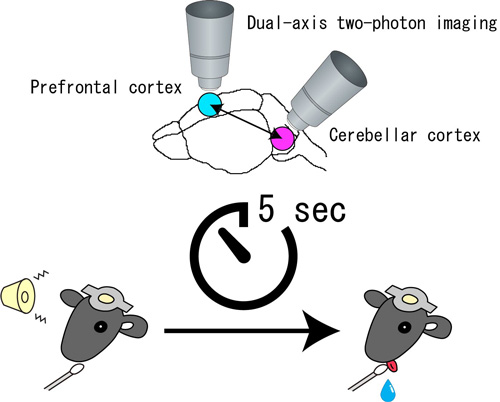
One can count seconds with precision, but psychiatric patients cannot - how does the brain precisely count seconds? Prefrontal cortex can maintain information for seconds, whereas the lateral cerebellum interacting with the prefrontal cortex is known to have an internal clock. Elaborate coordination between these brain areas may enable precise timing-based behavior, however, the circuit basis remains unknown. In this study, the circuit basis for cerebelloprefrontal coordination will be analyzed by using dual-axis two photon imaging in mice performing a timing task. The causal relationships between these neuronal population activities and precisely timed behavior will be addressed by using optogenetics in both areas.
Causal clarification of temporal information processing network by brain connectivity manipulation
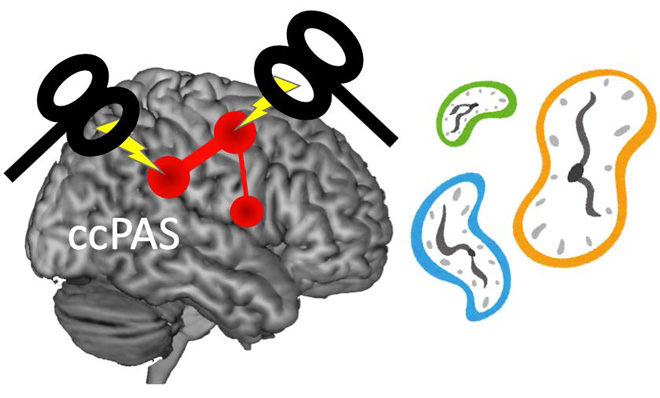
In our daily lives, we estimate the length of time in many situations, such as "pausing" a conversation or "timing" a start, to help us predict future events and plan our actions. In conventional research, the identification of brain regions that represent temporal information and their roles have been actively examined and discussed. On the other hand, recent studies have suggested that information transfer between brain regions may be important for time perception. In this study, we aim to identify the transmission pathways of temporal information in the human brain and to clarify their role in subjective time perception. First, we will use functional brain imaging and magnetoencephalography to clarify the pathways and dynamics of temporal information transmission, and then we will manipulate the functional connectivity between brain regions using techniques such as cortico-cortical paired associative stimulation (ccPAS) to examine the effects on time perception. In this way, we aim to elucidate the causal relationship between temporal information processing networks and subjective time.
Chrono-connectome-dynamics of prospective memory in children
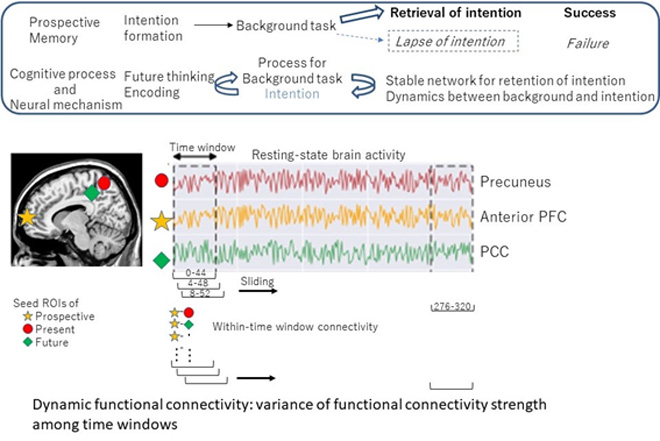
Prospective memory is the ability to remember to execute delayed and future intentions. Maintaining the intention in mind while engaging background tasks, then, remembering the intention spontaneously. Prospective memory is involved in social independence of children, however, neural mechanism of prospective memory in the developmental stage has not been elucidated. In this study, functional network associated with prospective memory success in children will be examined with resting-state functional MRI. With cross-sectional design, effects of age on functional connectivity associated with prospective memory will be explored. In addition to stable neural network for maintenance of prospective intention, dynamics of functional connectivity (chrono-connectome-dynamics) across monitoring intention and background task processing are to be verified.
Evolution of the time window of integration: comparative auditory evoked potential study with six mammalian species
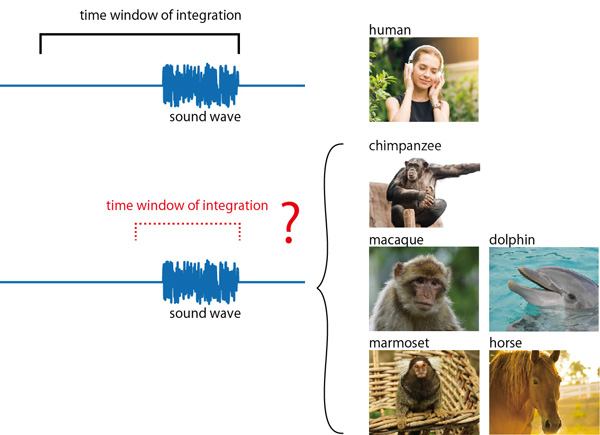
Sensory information is integrated over time for obtaining neural representations of sensory events in the brain. Temporal integration occurs at each level of sensory processing, from peripheral to central, and the time scale of integration generally becomes longer at higher levels of processing, reflecting accumulation of information over time. It would not be surprising if there were species differences in the time window of integration at the level of cerebral cortical processing. However, this possibility has never been investigated in neuroscience, to our knowledge.
This project uses noninvasive recording of auditory evoked potentials (AEPs) to address this problem in a comparative auditory neurophysiology experiment using four primate species (human, chimpanzee, macaque, and common marmoset) and two large mammals (dolphin and horse). A unique advantage of noninvasive AEP is that, by using a common measure across species, direct species comparisons become possible. We aim to delineate species differences in the time window of auditory integration, by measuring AEP indices that have been established in humans to reflect temporal integration in hearing.
Elucidation of external factors and brain regulators that restore the lost past
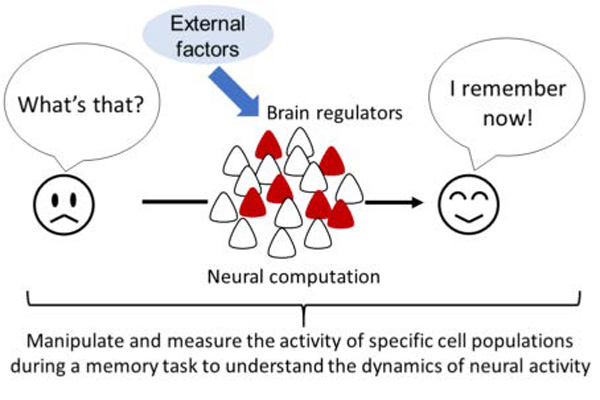
The past, which is a part of our mental time, is established by the memory system in the brain. The past is lost after a long period of time or due to neurodegenerative disorders such as Alzheimer's disease. However, even after the past seems to have been lost, memory traces remain in the brain in many cases. Therefore, the past can be recovered spontaneously. However, it is unclear what external factors cause the recovery of the seemingly lost past, and the neural mechanisms that cause the recovery of the past. In this study, we aim to identify the external factors that regulate the ability to recall the past and to elucidate the neural mechanisms by which these external factors modulate recall. In particular, we will selectively manipulate and measure the activity of specific cell populations to reveal the dynamics of precisely regulated neural networks and to clarify the relationship between neural activity and phenomena related to "mental time".
Transformation of neural activity and synaptic representations of long-term memory during
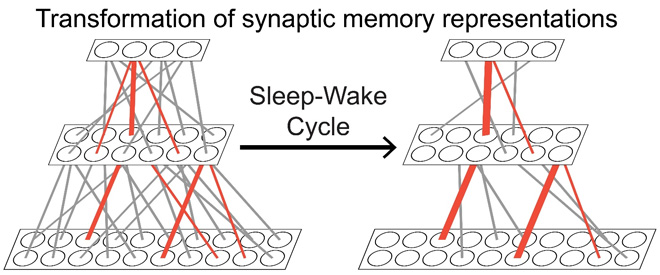
The neural circuits of the brain are constantly reorganized during the sleep-wake cycle. Learning during wakefulness activates neurons and enhances synaptic strength, forming signals that retain long-term memory. In reverse, sleep weakens neuromodulation and average synaptic strength. Weakening of average synaptic strength during sleep is suggested to play a role in maintaining neural circuitry homeostasis. However, as conventional synaptic plasticity studies often report average changes, the effect of sleep on memory representations in the brain remains unclear. Therefore, this study performs optogenetic experiments at individual synaptic levels in mice to elucidate the transformation of memory representations in the brain.
Here, we aim to answer questions such as "Why do you make memory mistakes?", "Why do you feel refreshed after sleep?", and "Does studying hard saturate your brain?"
Reexamining dopamine clock hypothesis
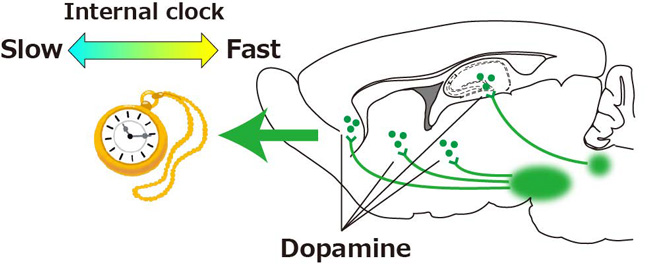
Dopaminergic system is a key regulator in control of subjective time perception. Previous pharmacological studies in both human and animal subjects have shown that an increase of dopamine speeds up the internal clock. However, more recent study utilizing dopamine neuron specific imaging and manipulation suggested that activities of some dopamine neurons slow down the internal clock. In this project, we reexamine ‘dopamine clock hypothesis' by using multi-site dopamine imaging and optogenetic manipulation of dopamine release.
Effects of social information on time processing associated with functional connectivity between amygdala and striatum

You will feel like a long time when you get yelled at by your parents or bosses. On the other hand, time seems to pass by fast when you spend a fun time with your friends or lovers. Time processing is subject to influence of social information. In this study, we aim for elucidation of neural mechanisms underlying influence of social information on time processing.
One brain area of candidates for time processing is the striatum, and one of candidates for social information processing is the amygdala. There is a strong neuronal projection from the amygdala to the ventral striatum. Thus, we hypothesized that social information processed in the amygdala is sent to the ventral striatum, and influences time processing in the striatum. The aims of our study are: (i) behavioral analysis of time discrimination influenced by social information in macaque monkeys and (ii) to elucidate of functional connectivity between the amygdala and the ventral striatum and (iii) to establish the causality between functional connectivity between the amygdala and the ventral striatum and the influence of social information on time processing.
Chronobiology in hibernation-like behavior

Long-term hypothermia and hypometabolism state (hibernation-like state) can be induced in mice by activation of neurons located in anteroventral periventricular nucleus (AVPe) containing QRFP. In the hibernation-like state, the setpoint of body temperature is decreased, but homeostatic thermo regulation is still working and the vital function is maintained under the hibernation-like state. The neuronal activity and cognitive function is supposed to be suppressed in this state. In this study, we aim to understand how mice recognize the time and adopt to the environmental cycle, considering the clinical application of this technique in the future. We will investigate the dynamics of the circadian clock and memory function in the mice during hibernation-like behavior in vivo.